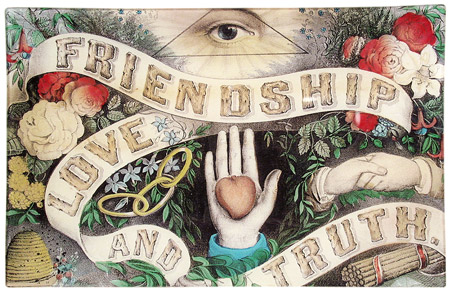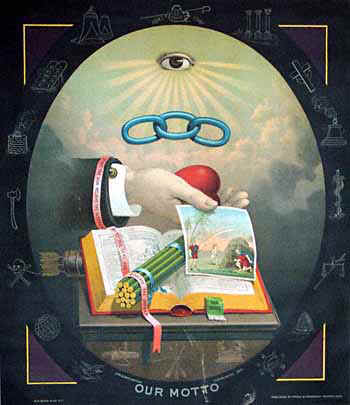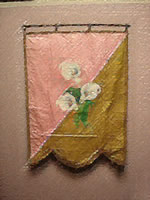

The Odd Fellows

History
There are several different reasons given for our strange name. One old and apparently authoritative history of Odd Fellowship gives the explanation, "That common laboring men should associate themselves together and form a fraternity for social unity and fellowship and for mutual help was such a marked violation of the trends of the times (England in the 1700's) that they became known as 'peculiar' or 'odd,' and hence they were derided as 'Odd Fellows.' Because of the appropriateness of the name, those engaged in forming these unions accepted it. When legally incorporated the title 'Odd Fellows' was adopted."
Another, similar explanation is that the original Odd Fellows were men who were engaged in various or odd trades, as there were organizations for some of the larger trades.
Yet another theory is that these were Masonic Lodges that did not want to be part of the Ancient and Accepted Order and therefore were "Odd" Lodges.
Among the first records of the Order in America is that of five Brothers of the English Order who met in New York City in 1806, and formed Shakespeare Lodge No. 1.
The founders were three boat builders, a comedian and a vocalist - a group befitting the name "Odd Fellows," indeed. The lodge was self instituted, a common practice in those times. Their first candidate was a retired actor who was the keeper of the tavern where they met. Accounts state that lodge meetings were accompanied by merry making and mirth, and that the wares of the tavern were freely indulged in. This lodge was dissolved in 1813 due to poor attendance brought on by controversy over the War of 1812.
Another lodge of which little is known existed briefly in New York in 1816. In 1818, Shakespeare Lodge in New York was re-instituted, in the Red Cow tavern, operated by a former member who had in his keeping the books and papers of the former lodge. They claimed to have received a charter from the Manchester Unity which gave them authority over all other Odd Fellows Lodges in the United States, but this authority was not accepted by other lodges. Several more lodges were founded in the New York City area, and one in Philadelphia, due to the efforts of the Brothers of Shakespeare Lodge.
The Independent Order of Odd Fellows as we know it today began in Baltimore, Maryland, where five members of the Order from England founded Washington Lodge No. 1 on April 26,1819, by self-institution. One of these Brothers was Thomas Wildey , the first Noble Grand and the man revered as the founder of Odd Fellowship in North America. A charter was received from Duke of York Lodge in Preston, England, in 1820, a year and a half after its self-institution.
A second lodge was formed in Baltimore in 1819, but these two lodges and those in New York were unaware of each others' existence for some time, communications being slow in those days, and there being no reason such information would travel from one city to another except by pure chance.
In 1821, the "Grand Lodge of Maryland and of the United States of America, of the Independent Order of Odd Fellows," was founded. Brother Wildey also served as the first Grand Master/Grand Sire of the first Grand Lodge, for a period of 12 years. Several more lodges were established, and in 1824, the "Grand Lodge of the United States" now termed "The Sovereign Grand Lodge," was separated from the Grand Lodge of Maryland. The Independent Order of Odd Fellows in North America (United States and Canada) became independent from the Order in England in 1834.
The individual interested in the Independent Order of Odd Fellows has probably read or perhaps repeated the Valediction of Odd Fellowship, by Past Grand Sire D. D. Monroe - 1944-1946, and no doubt realizes that it refers to "... my duty 'to visit the sick, relieve the distressed, bury the dead and educate the orphan'..." A person may wonder how this "duty" came to exist, and how relevant it is to Odd Fellowship in modern times. The English Odd Fellows' (the Manchester Unity) major objective was "relief" and that organization was primarily a mutual insurance fraternity in 1819 and remains as such to this day. Accordingly, our "duty" apparently is of American origin.
Ideals
History does tell us that the "duty" was extremely relevant in Baltimore, Maryland, when, for all practical purposes, North American Odd Fellowship was founded there in 1819, for that city was in the grip of a severe epidemic, and sickness, distress, death, and the inevitable result, orphans, were to be found everywhere.
Visiting the sick was a daring, bold thing to do in 1819, and indeed for in excess of one hundred years more, because of the very real possibility the visitors would contract the illness or disease. Odd Fellows, and Rebekahs after they came into existence in 1851, visited the sick as a matter of course. Odd Fellows and Rebekahs continue to this day to make special efforts to visit the sick.
Relief of the distressed was a major goal of most or all fraternal organizations, then and now. Odd Fellow Lodges normally provided monetary sick benefits to its members who were ill or injured and unable to work. A few California lodges still provide monetary sick and/or death benefits for members. Assistance to those in need, whether in the form of donations to charities, or donations of money or goods and services to members or others in the community is commonly provided today by all lodges.
 In addition, lodges commonly provided all kinds of assistance to members who were in need, such as a box of groceries, a cord of wood, or a member or visiting nurse to care for a seriously ill member at home. With the modern day social welfare programs operated by government agencies, these services by the Order are no longer as vital as they once were, but Odd Fellows and Rebekahs still provide friendship that members require for a wholesome and full life.
In addition, lodges commonly provided all kinds of assistance to members who were in need, such as a box of groceries, a cord of wood, or a member or visiting nurse to care for a seriously ill member at home. With the modern day social welfare programs operated by government agencies, these services by the Order are no longer as vital as they once were, but Odd Fellows and Rebekahs still provide friendship that members require for a wholesome and full life.
Burying the dead was taken very seriously by early Odd Fellows, and most lodges purchased land and established cemeteries as one of their first activities in a new town or city. In many areas all phases of burial (sometimes including services now provided by undertakers) were provided by Odd Fellows in the earlier days. Cemeteries were often open to the public, and plots were sold for a few dollars each. Many California lodges still own and operate cemeteries, and in some instances the major cemetery in the community is the Odd Fellows Cemetery.
Odd Fellow Lodges continue to conduct funeral and memorial services for members when requested prior to their death or by their families. This may be the only service, or may be in conjunction with a church service or with other organizations.
Educating the orphan was also taken seriously, and orphans of Odd Fellows, and Rebekahs too, could expect to receive at least a high school education through the lodge. In California the Rebekahs were in the forefront of caring for the orphans, and in the late 1800's they were granted authority to establish the Odd Fellow-Rebekah Children's Home in Gilroy. They likewise were in the forefront of providing funds to insure an education for orphans and needy children of members.
Caring for the widow likewise was and is one of the basic duties of all Odd Fellows, and it is comforting to realize that most lodges continue to include the widows of their members in lodge functions and activities. Remembering the widows on special holidays and at other special times during the year is a thoughtful way to demonstrate that Odd Fellows do care for those left behind. When the Odd Fellows Home of California was established it was to provide care for aged Odd Fellows and their wives, widows of Odd Fellows, and Rebekahs. Today this very same principle is applied when admitting new residents to our home in New Orleans.




Odd Fellows in New Orleans
Teutonia Lodge No. 10
This is the New Orleans Lodge for Odd Fellows, it administers to widows, orphans, the ill and the dead. This lodge is in the Back O' Town region. Inquiries of membership may be made on Monday evenings at 7 O'Clock sharp. See Mr. Billington.
The Odd Fellows Rest Cemetary
The cemetery was dedicated on Feb. 29, 1849, with a splendid ceremony and a grand procession led by two circus bandwagons, one pulled by 16 horses. There was also a funeral car carrying a sarcophagus of "quite imposing appearance." The membership had gathered the remains of 16 deceased members from other cemeteries in the city. These were carried in the funeral car and were the first burials in the group's new cemetery.
Within three years, the cemetery had erected 200 vaults and the tomb of the Teutonia Lodge No. 10. There are also walks laid out named for past grand masters of the Order.
